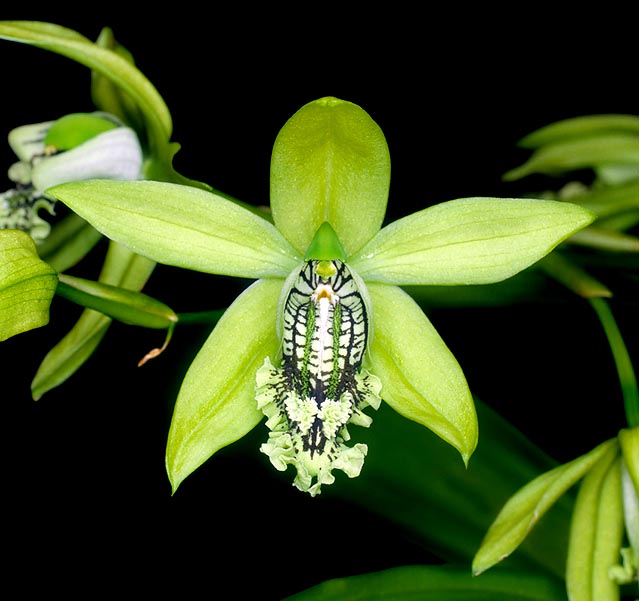Family : Orchidaceae

Text © Pietro Puccio

English translation by Mario Beltramini

Coleogyne mayeriana amazes for the composed beauty of its emerald green flowers. Lemon scent © G. Mazza
The name of the genus is the combination of the Greek terms “koilos” = hollow and “gyne” = female, with reference to the hollow stigma; the species refers to the name Mayer of two curators, father and son, of the botanical garden of Karlsruhe, who had furnished the material on which it has been described.
The Coelogyne mayeriana Rchb.f. (1877) is an herbaceous species with creeping rhizome from which originate, spaced of 5-20 cm, piriform, 5-9 cm long, pseudobulbs with at the apex two 15-35 cm long and 5-8 cm broad lanceolate leaves.
The inflorescences, produced at the centre of the emergent vegetation, are arcuate, up to about 40 cm long, carrying from 3 to 10 flowers with a scent of lemon, of pale emerald green colour, with numerous white warts and venations, and blackish spots on the labellum.
Ovate-lanceolate, 3-4 cm long and 1-1,5 cm broad central sepal, similar lateral sepals rather falcate, lanceolate, 2-4 cm long and 0,8-1 cm broad, petals, 3,5 cm long tri-lobed labellum with median lobe about 1,6 cm broad and crimped and undulated edges, 1-1,5 cm long pale green column.
The fruits are ellipsoid capsules of about 5 cm of length and of 2,5-3 cm of diameter. It reproduces by seed, in vitro, and by division, with each section provided with 3-4 pseudobulbs.
Species appreciated for the green colour of the flowers and the blackish spots on the labellum, similar to the Coelogyne pandurata, it requires, as this last one, a humid warm climate with temperatures of 22-32 °C in summer, 70-90% of humidity and partial shade; in winter, slightly lower temperatures, 16-26 °C, maximum luminosity, but not direst sun, and 60-80% of humidity; in all seasons a good circulation of air is essential.
The waterings must be regular in summer, letting to dry up partially before irrigating again, slightly more spaced in winter, without ever leaving the compost to dry up completely; water stagnations among the leaves of the emerging vegetation are to be avoided.
For the waterings and the nebulisations are to be utilized rainwater, water obtained by reverse osmosis or demineralised; the fertilizations, duly distributed in way to avoid salts accumulations, are to be done during the vegetative period, preferably with hydrosoluble balanced products, with microelements, at half, or less, dosage, than what suggested on the packages.
It is cultivable in pots or low and rather wide baskets, seen the somewhat cumbersome dimensions of the plant, with draining and well aerated compost which may be formed by a mix of medium-sized bark, sphagnum, coir and fragments of charcoal. Division and repotting are to be done by the appearance of the new roots at the base of the pseudobulb once this has completed the flowering.
The species is inscribed into the appendix II of the CITES (species whose trade is internationally ruled).
→ For general notions about ORCHIDACEAE please click here.
